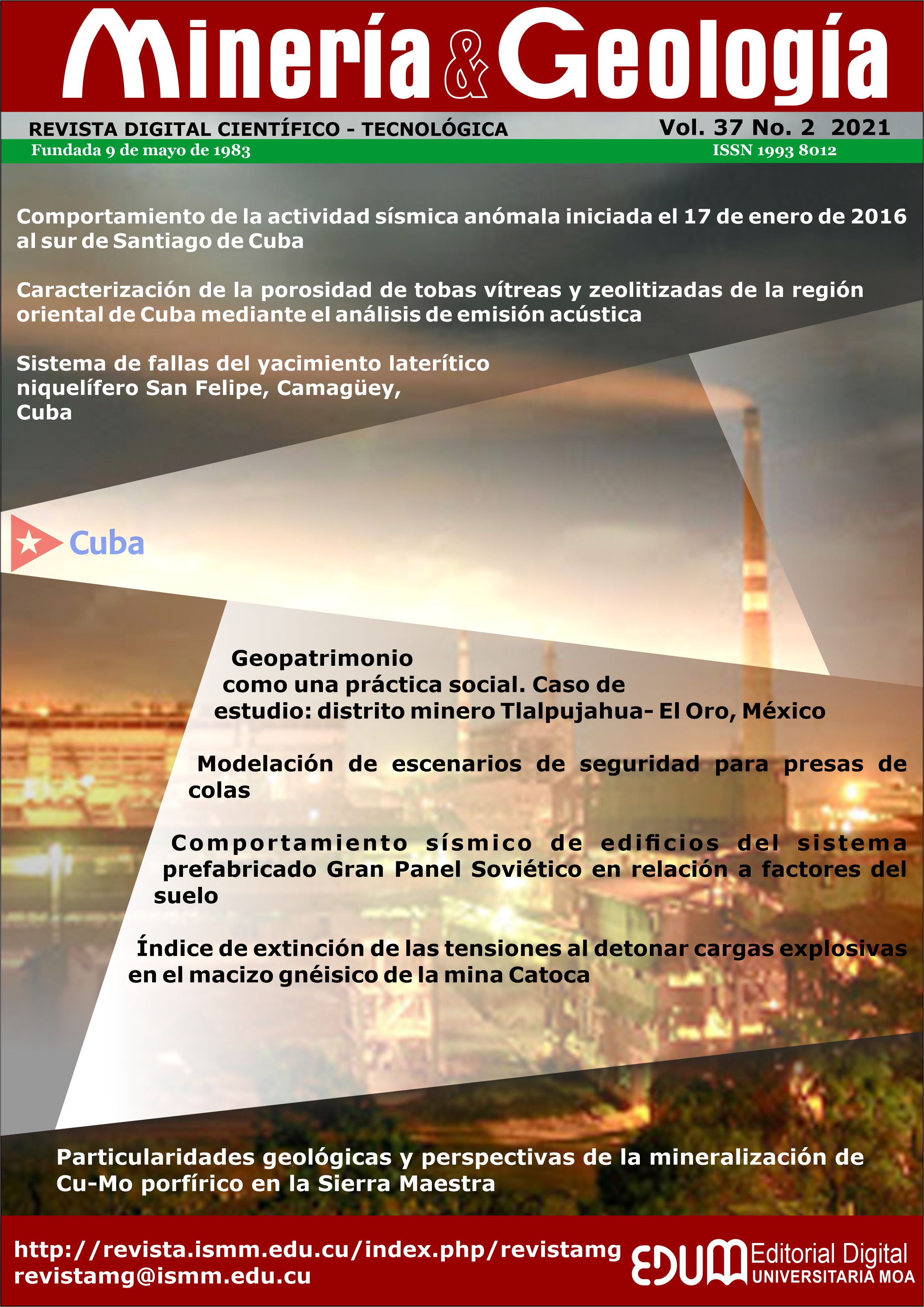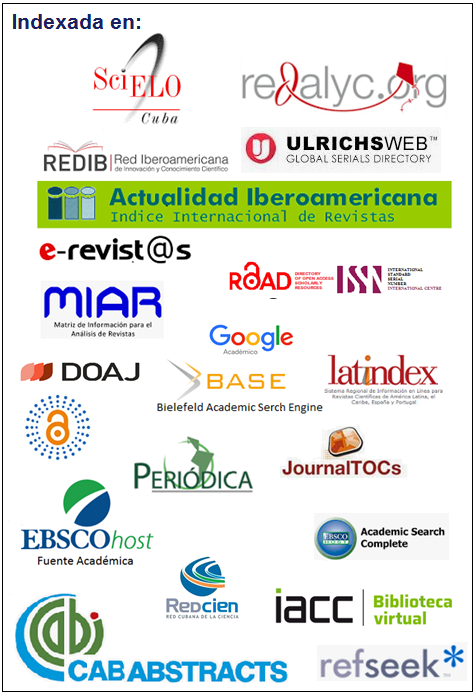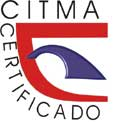Comportamiento de la actividad sísmica anómala iniciada el 17 de enero de 2016 al sur de Santiago de Cuba
Palabras clave:
sismicidad, réplicas, Santiago de Cuba, tensor del momento sísmico, ángulo de Kagan.Resumen
Se evaluó comportamiento y las posibles causas de la actividad sísmica al sur de la provincia de Santiago de Cuba, a partir de la información geológica y tectónica disponible y de los registros de los sismos ocurridos en esta región desde el 17 de enero del 2016 a las 08:17 UTC. El análisis de los parámetros espacio-temporal-energéticos de los terremotos evidenció la coherencia entre los resultados de tres de las redes que monitorean la región, a saber, Servicio Sismológico Nacional Cubano (SSNC), Servicio Geológico de los Estados Unidos (USGS) y el Centro Alemán de Investigaciones Geocientíficas (GEOFON)). Para tres de los terremotos se calcularon los tensores del momento sísmico mediante el proceso de inversión de las correspondientes formas de ondas. La comparación de los resultados de dos de ellos con los obtenidos por otras agencias que monitorean el área fue totalmente coherente con planos de fallas de orientación N-S con mecanismos focales compresivos. El tercer sismo, ocurrido una semana más tarde al este de la provincia, también tuvo un mecanismo compresivo, aunque con orientación NW-SE en el plano de falla. La actividad sísmica que en sus inicios se comportó como un enjambre de terremotos, manifestó posteriormente un comportamiento distinto, similar al de réplicas registradas tras un sismo de mayor energía, siguiendo la Ley de Omori, es decir, del tipo de evento premonitores-sismo principal-replicas.Descargas
Citas
Arango E. D. 2014: Análisis sismotectónico del territorio oriental de Cuba a partir de la integración del modelo de corteza 3D de datos gravimétricos con datos sismológicos y geodésicos. Tesis Doctoral. Centro de Investigación Científica y de Educación Superior de Ensenada, Baja California, México.
Arango, E., González, O., Palau, R. y Leyva, M. 2017: Evaluación del comportamiento de la actividad sísmica de Corralillo iniciada el 9 de enero de 2014. Revista Ciencias de la Tierra y el Espacio, 18(1): 71-85.
Brocher, T.M. 2008: Key elements of regional seismic velocity models for long period ground motion simulations. Journal of Seismology, 12(2): 217–221, doi: 10.1007/s10950-007-9061-3.
Calais, E. 1988: Aspect structural d une limite de plaques en coulissage: La froteniére Nord-Caraibe de Cuba á Hispaniola (Grandes Antilles). Diplome d´études approfondies a l´Universite de Bretagne Occidentale. Archivo CENAIS, 118p.
Calais, E. y Lepinay, B.M., 1991: From transtension to transpression along the northern Caribbean plate boundary off Cuba: implications for the Recent motion of the Caribbean plate. Tectonophysics, 186(3-4): 329-350.
Calais, E., Béthoux, N., y Lepinay, B.M., 1992: From transcurrent faulting to frontal subduction: A seismotectonic study of the Northern Caribbean plate boundary from Cuba to Puerto Rico. Tectonics, 11(1) : 114-123.
Chuy, T. 1999: Macrosísmica de Cuba y su aplicación en los estimados de peligrosidad y microzonación sísmica. Tesis en opción al Grado de Doctor en Ciencias Geofísicas. Fondos del MES y CENAIS. 150 p.
Dreger D. S. 2002: Time-DomainMoment Tensor INVerseCode (TDMT_INVC) Version 1.1, Berkeley Seismological Laboratory, pp. 18.
García, J.; Slejko, D.; Alvarez, L.; Peruzza, L.; Rebez, A. 2003: Seismic hazard maps for Cuba and sorrounding areas. Bull. Seism. Soc. Am., 93(6): 2563-2590.
Goldstein, P. 1999: SAC User’s Manual, Lawrence Livermore Laboratory, University of California.
González, O., Moreno, B., Romanelli, F. y Panza, G.F. 2012: Lithospheric structure below seismic stations in Cuba from the joint inversion of Rayleigh surface-waves dispersion and receiver functions. Geophys. J. Int., 189(2): 1047–1059. DOI: 10.1111/.j.1365-246X.2012.05410.x.
Graves, R. W., y Pitarka, A. 2004: Broadband time history simulation using a hybrid approach, Proc. En: 13th World Conf. Earthquake Eng., Vancouver, Canada, paper no. 1098.
Havskov, J. y L. Ottemøller. 2000: SEISAN earthquake analysis software. Seis. Res. Lett., 70(5): 532-534.
Havskov, J. y Ottemöller, L. 2010: Routine Data Processing in Earthquake Seismology. Springer Science+Business Media B.V. DOI 10.1007/978-90-481-8697-6_5.
Kagan, Y.Y. 1991: 3-D rotation of double-couple earthquakes sources. Geophys. J. Int., 106(3): 709-716. doi: 10.1111/j.1365-246X.1991.tb06343.x.
Krizova, D., Zahradnik, J., y Kiratzi, A. 2013: Resolvability of isotropic component in regional seismic moment tensor inversion. Bull. Seism. Soc. Am., 103(4): 2460–2473.
Mann P., Calais E., Ruegg J. C., DeMets Ch., Jansma P. E. y Mattioli G. S. 2002: Oblique collision in the northeastern Caribbean from GPS measurements and geological observations. Tectonics, 21(6): 1057.
Mogi, K. 1963: Some discussions on afterhsocks, foreshocks and earthquake swarms, the fracture of a medi-infinite body caused by inner stress origin and its relations to earthquake phenomena. Bull. Earthq. Res. Inst. Tokyo Univ., 41(3): 615-58.
Moreno, B., Grandison, M. y Atakan, K. 2002: Crustal velocity model along the southern Cuba margin: implications for the tectonic regime at an active plate boundary, Geophys. J. Int., 151(2): 632–645.
Nafe, J.E., yand Drake C.L. 1960: Physical properties of marine sediments, in The Sea, Vol.3, M.N.Hill (Editor), Wiley-Interscience, NewYork, 794–815.
Omori, F. 1894: On the aftershocks of earthquakes. Journal of the College of Science, Imperial University of Tokyo, 7: 111–200.
Sokos, E. N., y J. Zahradník. 2008: ISOLA a Fortran code and a Matlab GUI to perform multiple point source inversion of seismic data. Computers and Geosciences, 34(8): 967-977.
Sokos, E. N., y J. Zahradník. 2013: Evaluating centroid-moment-tensor uncertainty in the new version of ISOLA software. Seismol. Res. Lett., 84(4): 656-665.
Tsunami Laboratory. 2011: ICMMG SD RAS, Novosibirsk, Russia, Historical Tsunami Database for the World Ocean (HTDB/WLD), 1628 B.C to present, online http://tsun.sscc.ru/nh/tsunami.php.
Utsu, T. 1961: A statistical study of the occurrence of aftershocks. Geophysical Magazine, 30: 521–605.
Vackář J., J. Burjánek, y J. Zahradník. 2015: Automated detection of long-period disturbances in seismic records; MouseTrap code. Seism. Res. Letters, 86(2A): 442-450.
Wessel, P., W. H. F. Smith, R. Scharroo, J. Luis, y F. Wobbe, 2013: Generic Mapping Tools: Improved Version Released, EOS Trans. AGU, 94(45): 409-410. doi:10.1002/2013EO450001.
Zahradník, J., y A. Plešinger. 2005: Long-period pulses in broadband records of near earthquakes, Bull. Seismol. Soc. Am., 95(5): 1928–1939, doi10.1785/0120040210.
Zahradník, J., y A. Plešinger. 2010: Toward understanding subtle instrumentation effects associated with weak seismic events in the near field. Bull. Seismol. Soc. Am., 100(1): 59–73, doi 10.1785/0120090087.
Zahradnik, J., y Custodio, S. 2012: Moment Tensor Resolvability: Application to Southwest Iberia. Bull. Seismol. Soc. Am., 102(3): 1235–1254. doi:10.1785/0120110216.
Publicado
Cómo citar
Número
Sección
Los autores que publican en esta revista están de acuerdo con los siguientes términos:
- Licencia Creative Commons Atribución-NoComercial permite que el beneficiario de la licencia tenga el derecho de copiar, distribuir, exhibir y representar la obra y hacer obras derivadas para fines no comerciales siempre y cuando reconozca y cite la obra de la forma especificada por el autor o el licenciante.
- Los autores pueden establecer por separado acuerdos adicionales para la distribución no exclusiva de la versión de la obra publicada en la revista (por ejemplo, situarlo en un repositorio institucional o publicarlo en un libro), con un reconocimiento de su publicación inicial en esta revista.
- Se permite y se anima a los autores a difundir sus trabajos electrónicamente (por ejemplo, en repositorios institucionales o en su propio sitio web) antes y durante el proceso de envío, ya que puede dar lugar a intercambios productivos, así como a una citación más temprana y mayor de los trabajos publicados (Véase The Effect of Open Access) (en inglés).
- Lo anterior debe realizarse siempre sobre el artículo ya publicado por Minería y Geología.
La revista permite que los autores tengan los derechos de autor sin restricciones
La revista permite que los autores conserven los derechos de publicación sin restricciones




